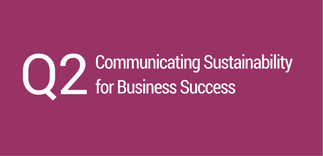Communications – Reaching Your Target Audience
Friday, June 2nd, 2017

To fully reap the benefits of being a responsible business you must communicate your responsible business / CSR initiatives effectively. Last year our Q2 2016 Network Meeting explored CSR communications through storytelling and through making your message matter – essentially what message to communicate. But having a great story to tell is of little use unless you’re reaching your audience. So our Q2 2017 Network Meeting focused on how to communicate your CSR message and on how your organisation is leveraging communication channels to reach its audience.
“If you care about your audiences use a medium, and an approach, they will relate to as your starting point.” These are the words of our event’s key note speaker Mallen Baker – a writer and strategic advisor on corporate social responsibility for over twenty years. Mallen is also the voice behind The Respectful Business Blog where he shares his CSR insights.
One medium Mallen thinks cannot be ignored is social media. Channels such as Twitter, YouTube, Facebook, Snapchat and LinkedIn are crucial. According to Mallen, Facebook is the ‘tool of the moment’ for really focussed channelling. Social media has changed the face of communications. Audiences nowadays are likely to access information via their smart phones and they no longer come looking for your story. Often you have to go to them. Companies need to be prepared for this. They need to tailor their content accordingly.
It is important that organisations measure the impact of their communications. While many communicate regularly, few check their message is resonating. To be really effective, companies need to consider having someone in place to ensure communications are working.
The ability for companies to ‘boost’ their posts is a just one effective way to target specific audiences. YouTube is popular but if your video is to be successful, the video content must be both interesting and compelling. It must grab the audience within the first 20 seconds. A good example is Starbucks’ Upstanding video series which celebrates ordinary people doing extraordinary things to create positive change in their communities. What is interesting is how Starbucks facilitates increased awareness of social issues via its videos. Starbucks isn’t the hero of the story. Instead it uses the resources available to it to do something good, and people remember that.
The era of the CEO sending a video message is gone, in Mallen’s view. A company being the hero doesn’t land well. It’s no longer impactful. Compare the Heineken ad to this Pepsi ad to see how this is true. Instead, Mallen advocates utilising people with strong social connections to promote your story. Utilising YouTube influencers is a particularly good strategy as it allows companies to get authentic narrators to tell their story to the audience. Heineken’s zero carbon brewery was provided as an example of how a company can get it right. The company had a blogger go to their brewery, experience for himself what Heineken was doing, and blog about it live. As this blogger already had followers, and an established audience, the message had a wide reach.
Tips:
- Build on existing audience – g. the Heineken zero carbon blog
- Work in progress – Talk about the work in progress stories too. Companies often wait until they have the end result and communicate a finished glossy story. A work in progress, where the company talks about its challenges, grabs a lot more interest. Ford, for example, published an article about their desire to reduce their environmental impact, yet consumer demand meant they had to keep making high impact vehicles like 4x4s etc. Elon Musk, in contrast, is transforming the automotive industry. He hasn’t completely done it yet, but the work in progress story is interesting and people talk about it.
- Targeted messages – Boosting your post on Facebook allows you to target your message to specific audiences.
- Measure impact – ensure you understand whether your message is reaching its audience by measuring the impact – this can be through analysing social media analytics or surveying your target audience.
- You can download the slides from the presentation here.
- You can watch Bernadette Phelan, Head of Advisory updates on the network here.
- You can watch Moira Horgan’s speech on “Employees-Your Reputation Army” here.
- You can watch Mallen Baker presentation “External Communications” here.
